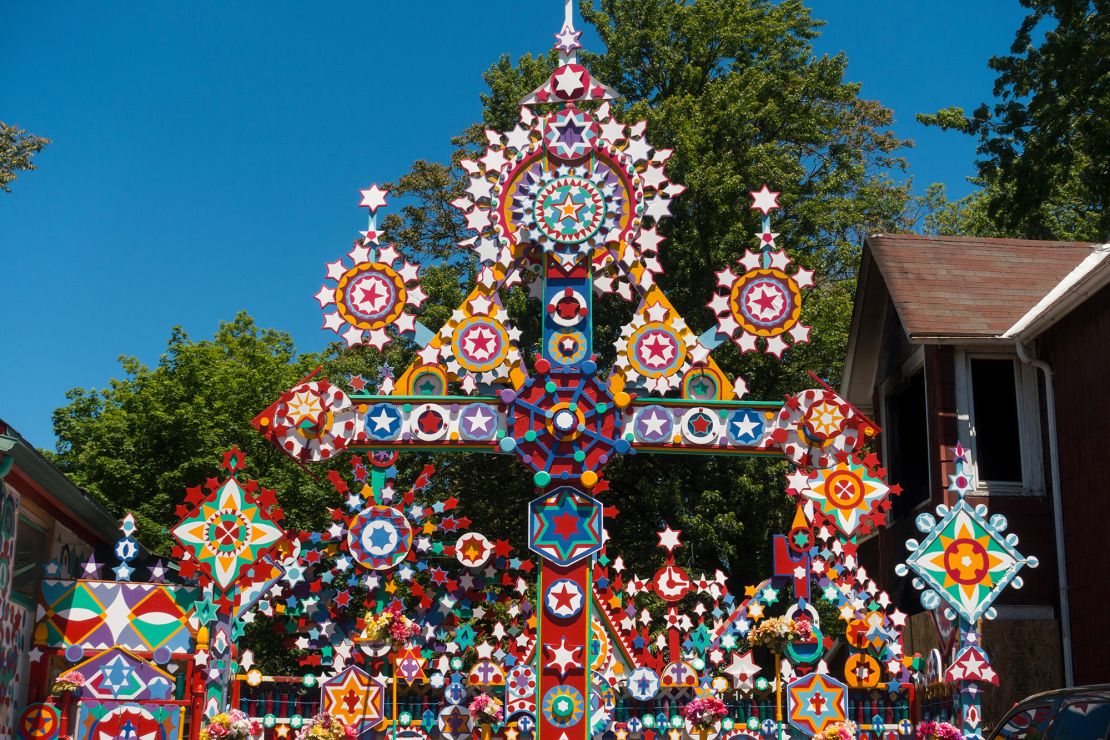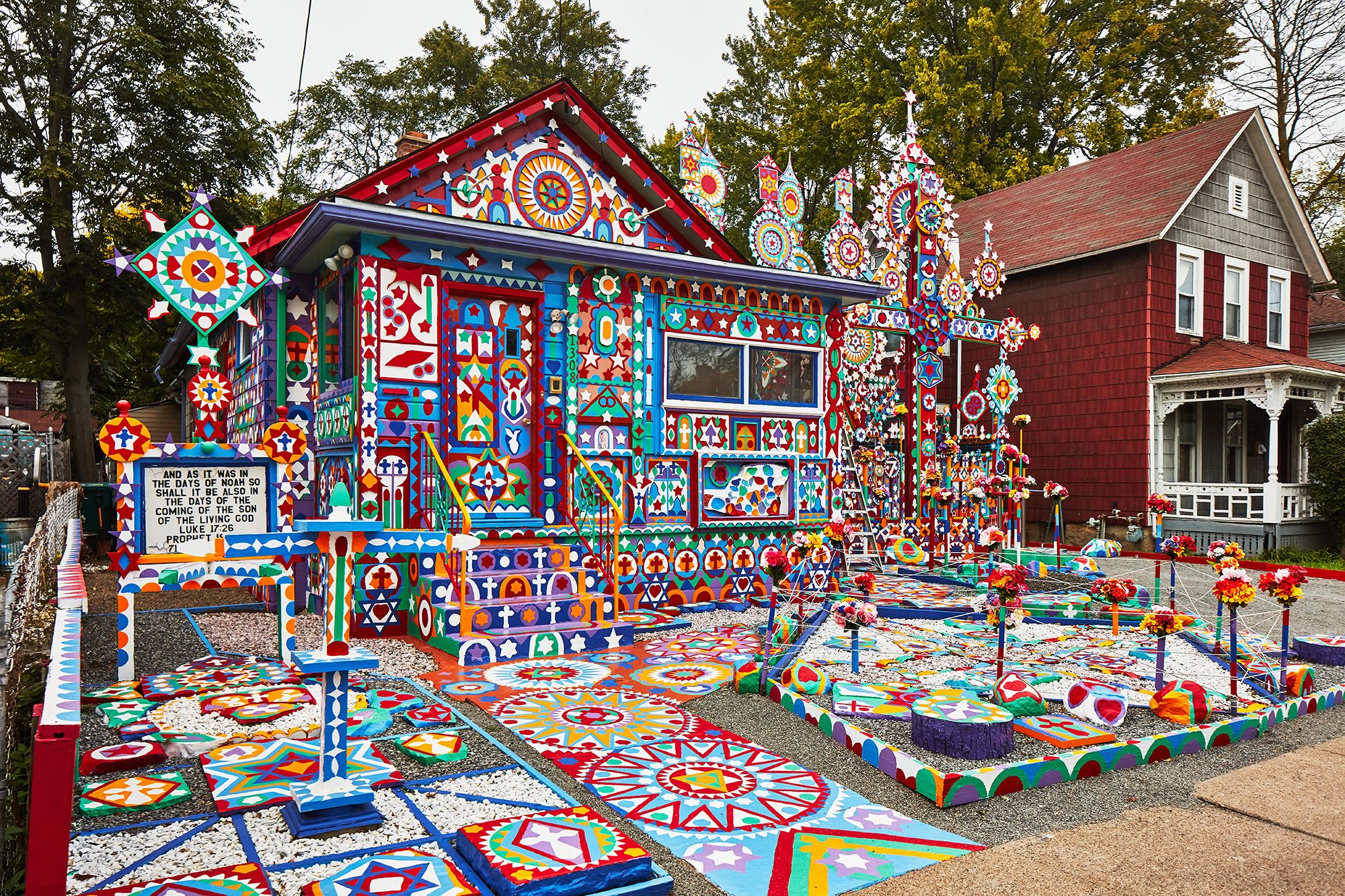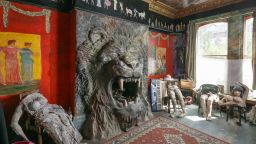Editor’s Note: This article was originally published by The Art Newspaper, an editorial partner of CNN Style.
(CNN) — The colossal cascades and currents that flow by Niagara Falls have inspired countless artists with their majesty, but Isaiah Robertson was compelled by a vision that they would be the backdrop to the apocalypse. Calling himself the Prophet Isaiah, Robertson spent years painting elaborate wooden cut-out shapes with symbols, including stars and crosses in a riot of colors, to adorn his home — inside and out.
Situated on a main street in a residential neighborhood, his kaleidoscopic assemblages stood out amid the brick and vinyl siding on either side, especially as they became more ornate over the years.
“I spent an enormous amount of time there, and people would all the time stop their cars because it’s an arresting experience, and he really enjoyed talking to people and giving tours,” says Fred Scruton, who has photographed art environments across the US. He first visited what’s known as the Prophet Isaiah’s Second Coming House in 2010. “He wouldn’t even take credit for it. He said it was God moving his hand.”
Preserving ‘something magical’
Born in Jamaica in 1947, Robertson moved to Canada as a young adult before relocating to Niagara Falls in 2004. While working as a carpenter on a renovation project at his local church he experienced what he described as a prophecy, which spurred his art.
Following Robertson’s death in 2020, however, the fate of his house was uncertain. Despite having one of the country’s leading tourist destinations, the city of Niagara Falls has experienced a population loss since the 1960s, alongside the economic fallout experienced by many Rust Belt communities.
Seeking to safeguard the space, Scruton contacted the Wisconsin-based Kohler Foundation, which has a focus on art environments, to preserve what he called “something magical in this low-income residential area.”
“Kohler Foundation strives to preserve art environments in situ whenever possible,” said Liesl Testwuide, the foundation’s senior preservation manager, adding that maintaining a community context was essential. “The site is a beacon of hope in a fairly depressed area and provides pride of place, which enriches the culture of Niagara Falls.”

After Kohler Foundation acquired the site, the art preservation company B.R. Howard & Associates (BRH) was contracted in 2021 for its conservation, which was not just challenging for the density of the art — from paintings on the sidewalk representing the Seven Seals in the Book of Revelation to decorated rocks arranged in a tree bed to evoke the tomb of Christ — but due to for its deterioration from the years of Western New York winters. Every single piece, down to the last heavenly cut-out star, was documented and evaluated before the whole site was dismantled.
“We printed dozens of enlarged images at various angles and built a miniature 3D diorama of the art features,” said Braeden Howard, lead project manager and associate conservator with BRH. “We then had a digital reconstruction generated using software that let us determine which columns and art feature layers would have to be installed first and in a sequential order that would allow everything to fit tightly together. If anything was installed in the wrong order, it would prevent the features from ever fitting into their proper orientation, and it would never match Robertson’s original vision and creation.”
The reassembled Second Coming House includes some elements replicated with PVC for their long-term stability, but all meticulously matched to Robertson’s loose freehand style. In October 2023, the site was gifted to the Niagara Falls National Heritage Area (NFNHA) for its future stewardship. It is planned to open to the public this summer as both an art destination and a community gathering space.
“The power of this project is not only in preserving an art environment but in revitalizing a neighborhood, which is critically important to places like Niagara Falls that have had decades of decline,” said Sara Capen, NFNHA’s executive director. “It has led the neighbors that are directly next to it to improve their porches, to do small construction projects, to plant a garden. That’s a powerful testament to what preservation can do. It’s an extension of what we feel is the artist’s energy, this is what he put out here to the world.”
Although many people pass through Niagara Falls to get a view of one of North America’s natural wonders, Capen said she hopes that the house’s story of human creativity will resonate with visitors. And if the Rapture ever brings the souls of the multitudes down Ontario Avenue to Robertson’s doorstep, they will still be welcomed with jubilant art meant to guide them to salvation.
Read more stories from The Art Newspaper here.





